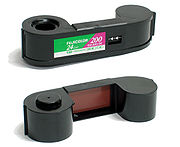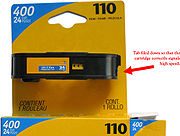
110 film
Encyclopedia

- For the unrelated roll-film format produced from 1898 to 1929, see 110 film (roll format)110 film (roll format)110 was the number later given by Kodak to a roll film format originally introduced in 1898. 110 film produced 5×4-inch images and was discontinued in October 1929....
.
110 is a cartridge-based film format
Film format
A film format is a technical definition of a set of standard characteristics regarding image capture on photographic film, for either stills or movies. It can also apply to projected film, either slides or movies. The primary characteristic of a film format is its size and shape.In the case of...
used in still photography
Photography
Photography is the art, science and practice of creating durable images by recording light or other electromagnetic radiation, either electronically by means of an image sensor or chemically by means of a light-sensitive material such as photographic film...
. It was introduced by Kodak in 1972. 110 is a miniaturised version of Kodak's earlier 126 film
126 film
126 is the number given to a cartridge-based film format used in still photography. It was introduced by Kodak in 1963, and is associated mainly with low-end point-and-shoot cameras, particularly Kodak's own Instamatic series of cameras....
format. Each frame is 13 millimetre, with one registration hole
Registration pin
A registration pin is a device intended to hold a piece of film, paper or other material in place during photographic exposure, copying or drawing....
.
The film is fully housed in a plastic cartridge, which also registers the image when the film is advanced. There is a continuous backing paper, and the frame number and film type are visible through a window at the rear of the cartridge. The film does not need to be rewound and is very simple to load and unload. It is pre-exposed with frame lines and numbers, a feature intended to make it easier and more efficient for photofinishers to print.
Unlike later competing formats, such as disc
Disc film
thumb|Cartridge of disc filmDisc film was a still-photography film format aimed at the consumer market, and introduced by Kodak in 1982.The film was in the form of a flat disc, and was fully housed within a plastic cartridge...
and APS
Advanced Photo System
Advanced Photo System is a film format for still photography first produced in 1996. It was marketed by Eastman Kodak under the brand name Advantix, by FujiFilm under the name Nexia, by AgfaPhoto under the name Futura and by Konica as Centuria.- Design :The film is 24 mm wide, and has three...
film, processed 110 negatives were returned in strips, without the original cartridge.

History
The 110 cartridge was introduced by Kodak in 1972 with Kodak Pocket Instamatic cameras. The new pocket-sized cameras became immediately popular, and soon displaced competing subminiature cameras, such as the Minolta 16Minolta 16
Minolta 16 refers to a line of 16mm subminiature cameras made by Minolta between 1955 and 1974. The Minolta 16 was the company's first widely successful product, helping to establish its popularity in the world market. The negative size was 10x14 mm for the earlier models, later, a larger format,...
series, from the market.
Fujifilm
Fujifilm
is a multinational photography and imaging company headquartered in Tokyo, Japan.Fujifilm's principal activities are the development, production, sale and servicing of color photographic film, digital cameras, photofinishing equipment, color paper, photofinishing chemicals, medical imaging...
stopped manufacturing 110 in September 2009.
Estes Industries
Estes Industries
Estes Industries is a company based in Penrose, Colorado, USA that designs and builds model rocket and model aircraft engines and kits. They were the best known model rocket company during the "golden age of rocketry" in the 1970s and early 1980s, competing primarily with Centuri Engineering and a...
has long marketed several model rockets, the most notable being the Astrocam
Astrocam
The Astrocam is a model rocket with a built-in camera for taking aerial photographs.The Astrocam comes from the American manufacturer Estes and it can be flown by B6-4-and C6-7-propellants. The Astrocam was available as kit or as ready-to-fly model. The camera used 110 film and was mounted in the...
, with a simple 110 camera in the nose; the shutter is triggered when the nose cone separates from the rocket body.
Design and technical issues
Although the format is most closely associated with cheaply-produced, low-cost cameras, Canon, MinoltaMinolta
Minolta Co., Ltd. was a Japanese worldwide manufacturer of cameras, camera accessories, photocopiers, fax machines, and laser printers. Minolta was founded in Osaka, Japan, in 1928 as . It is perhaps best known for making the first integrated autofocus 35mm SLR camera system...
, Minox
Minox
The Minox is a subminiature camera conceived in 1922 and invented in 1936 by German-Latvian Walter Zapp, which Latvian factory VEF manufactured from 1937 to 1943. After World War II, the camera was redesigned and production resumed in Germany in 1948. Originally envisioned as a luxury item, it...
, Pentax
Pentax
Pentax is a brand name used by Hoya Corporation for its medical-related products & services and Pentax Ricoh Imaging Company for cameras, sport optics , etc. Hoya purchased and merged with the Japanese optics company on March 31, 2008. Hoya's Pentax imaging business was sold to Ricoh Company, Ltd...
, Rollei
Rollei
Rollei is a German manufacturer of optical goods founded in 1920 by Paul Franke and Reinhold Heidecke in Braunschweig, Lower Saxony, and maker of the Rolleiflex and Rolleicord series of cameras...
, Voigtländer
Voigtländer
Voigtländer is an optical company founded by Johann Christoph Voigtländer in Vienna in 1756 and is thus the oldest name in cameras. It produced the Petzval photographic lens in 1840, and the world's first all-metal daguerrotype camera in 1841, also bringing out plate cameras shortly afterwards...
, and others, as well as Kodak, offered sophisticated, expensive 110 cameras, with excellent multi-element focusing lenses and precise, electronically controlled exposure systems. Such cameras are capable of making high-quality images on 110 film. Some of these cameras are quite small and still hold appeal to subminiature-photography
Subminiature photography
Subminiature photography is photography with unusually small cameras using unusually small film formats. It is distinct from photomicrography, photographing microscopic subjects with a camera which is not particularly small....
enthusiasts.
However, most 110 cameras have been cheaply made, with mediocre lenses and only rudimentary exposure control. The small negative
Negative (photography)
In photography, a negative may refer to three different things, although they are all related.-A negative:Film for 35 mm cameras comes in long narrow strips of chemical-coated plastic or cellulose acetate. As each image is captured by the camera onto the film strip, the film strip advances so that...
size of 110 film makes it difficult to enlarge successfully. For these reasons, the 110 format is associated with prints that are often rather grainy and unsharp. This has led to the misconception that the cartridge itself is incapable of holding film flat enough for making high-quality negatives.

The last 110 film that Kodak produced was ISO 400 speed packed in a cartridge that senses as "low" speed. As shown in the photograph to the right, these cartridges can be modified by hand so that they signal the proper speed to the camera.
In 2010 Adox
ADOX
In photography, ADOX is a trademark with a long history. It was originally a brand name used by the German company, Fotowerke Dr. C. Schleussner GmbH of Frankfurt am Main, the world's first photographic materials manufacturer. The company's founder, Dr...
announced that their new Adox Pan 400 black and white film to be released in mid 2011 will be eventually sold in 110 format, making this the first black and white 110 film available for many years and also the only 110 film type that is available with the discontinuation of Kodak 110 film. However with the problems that the first test coating of Adox Pan 400 experienced, the release date has been pushed back and there is no set date for the release of it in 110.
Film types
Although the format is commonly associated with print film, Kodak also produced KodachromeKodachrome
Kodachrome is the trademarked brand name of a type of color reversal film that was manufactured by Eastman Kodak from 1935 to 2009.-Background:...
110 slide film until 1982.
Along with standard sized slides that fit into standard projectors, 110 slide film could also be processed into smaller format slides. The latter required special Pocket Carousel
Carousel slide projector
A carousel slide projector is a common form of slide projector, used to project slide photographs and to create slideshows. The first carousel slide projector was invented by Louis Misuraca, who immigrated to the United States from Naples, Italy when he was a child. Louis was paid a one-time fee...
projectors. The sub-miniature slides were mounted in small mounts. There were also mount adapters available that allowed the small mounts to be projected in a common projector. These adapters were not entirely satisfactory however, as to project the smaller slide at a size comparable to that from 35mm the projector had to be moved further from the screen, resulting in a dimmer image. The dedicated 110 projector overcame this by using a brighter lamp.
See also
- Minolta 110 Zoom SLRMinolta 110 Zoom SLRThe Minolta 110 Zoom SLR was a 110 format single-lens reflex camera produced by Minolta of Japan between 1976 and 1979. It was the first SLR in 110 format. It had an unusual, flattened shape. Other 110 SLRs were shaped like SLRs in larger formats, but the 110 Zoom SLR took the flat format of...
- One SLR to use the format. - Pentax Auto 110Pentax Auto 110The Pentax Auto 110 and Pentax Auto 110 Super are single-lens reflex cameras made by Asahi Pentax that use Kodak's 110 film cartridge. The Auto 110 was introduced with three interchangeable lenses in 1978. Three more lenses were introduced in 1981, and then the Super model was released in 1982....
- Another SLR to use the format.
External links
- 110 Cameras at Sub Club, a site on subminiature photographySubminiature photographySubminiature photography is photography with unusually small cameras using unusually small film formats. It is distinct from photomicrography, photographing microscopic subjects with a camera which is not particularly small....
.

